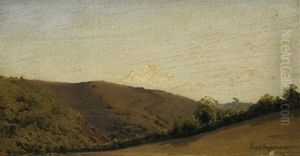Gustav Preyer Paintings
Gustav Preyer was a German painter known for his expertise in portrait painting and his work as a professor. Born on July 1, 1801, in Rostock, Mecklenburg-Vorpommern, Germany, Preyer grew up in an era when the artistic landscape of Europe was transitioning from Neoclassicism towards Romanticism. Despite this, Preyer's work remained largely influenced by the classicist tradition.
Preyer showed an early talent for the arts and pursued his passion by studying at the Prussian Academy of Arts in Berlin. He honed his skills under the tutelage of renowned artists such as Wilhelm Schadow, who was known for his romantic and religious-themed paintings. Preyer's education and mentorship under prominent figures of the time shaped his classical style, which was characterized by meticulous attention to detail and a clear influence from the Old Masters.
Throughout his career, Preyer was recognized for his portraits which captured not only the likeness but also the character and social standing of his subjects. His portraits were in high demand among the bourgeoisie and nobility, and he was known to have a keen ability to depict his subjects with dignity and elegance. In addition to portraiture, Preyer also painted historical subjects, though these works are less well-known today.
In 1834, Preyer became a member of the Berlin Academy and later, in 1857, he was appointed a professor there. His position at the academy allowed him to influence a generation of artists, imparting his classical techniques and values to students. As an educator, he was respected for his knowledge and for fostering the development of young artists.
Preyer's legacy is one of a classical portraitist who upheld the traditions of his forebears while also helping to shape the future of German art through his teachings. His works are held in private collections and museums, and they continue to be studied for their representation of 19th-century European portraiture. Gustav Preyer died on October 13, 1889, in Berlin, leaving behind a body of work that reflects the tastes and cultural aspirations of his time.


